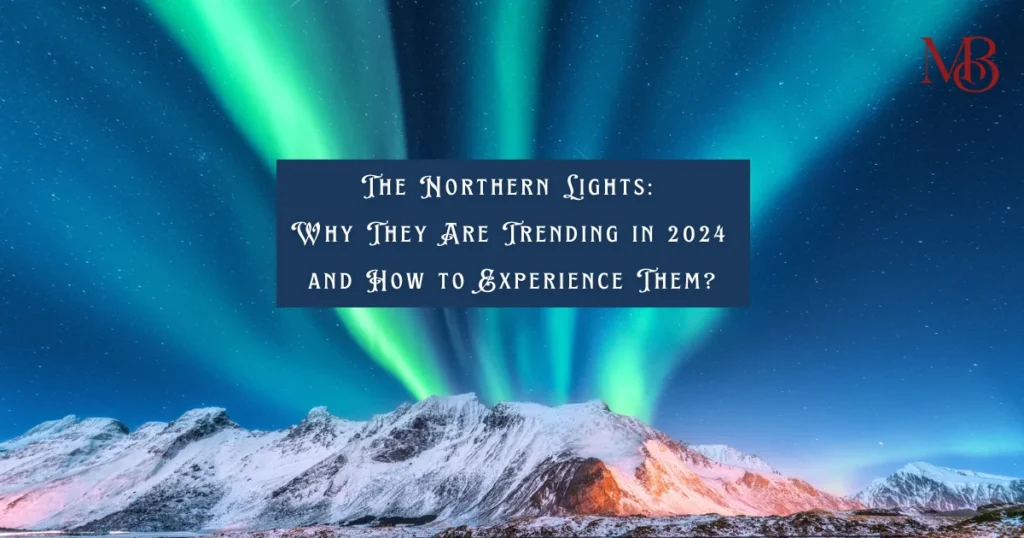The fabulous northern lights, commonly referred to as the aurora borealis, have fascinated the people of this earth since time immemorial. But recently, it has gained popularity due to its increasing visibility over territories where such episodes are rarely recorded.
This triggered broad interest in the spectacular display because several regions were reporting sightings. In this blog entry, we will look into why the northern lights are trending, the science behind the phenomenon, and how you can increase your chances of viewing the displays.

What Are the Northern Lights?
Northern lights are those shimmering, chromatically light formations in the sky and most of them appear at night time near the polar regions. This is a purely natural phenomenon created when Earth’s magnetic field and atmosphere interact with charged particles of the sun. Collision with gases such as oxygen and nitrogen gives out energy in the form of light and produces a spectacular range of colors; mostly green but sometimes red, purple, and violet.
Auroras are generally found in polar areas because the Earth’s magnetic field in these regions is strong; this enables them to channel most solar particles toward the poles. In the southern hemisphere, it is referred to as aurora australis or southern lights, while in the northern hemisphere, is termed aurora borealis or northern lights.
Why are Northern Lights trending in 2024?
The main cause of why northern lights are trending this year is thanks to a powerful solar storm caused by a coronal mass ejection or CME from the sun. This huge outburst of plasma and magnetic fields is flung from the sun’s corona, and when these particles hit Earth’s magnetic field, it puts all the puzzle pieces in perfect alignment for fantastic auroras.
A great solar flare of October 2024 sent a CME toward Earth, which ignited a geomagnetic storm. This has made the northern lights to be observed much farther south than usual. People from as far afield as Northern California, Alabama, and even parts of the United Kingdom reported the auroras. As for the solar cycle that reaches its peak every 11 years, it is also nearly at its maximum, thereby making the lights much more intense.
This high exposure is the reason why northern lights have managed to attract world attention and still are trending.
The Science Behind the Northern Lights
Now, knowing how the northern lights work only adds to their sense of wonder. The sun constantly puts out streams of charged particles current shorthand term for these streams is the solar wind. The majority of these are deflected by Earth’s magnetic field, but more penetrate this magnetic shield during periods of heightened solar activity or solar storms.
This collision with the oxygen and nitrogen atoms of the Earth’s atmosphere gives rise to the solar particles; the specific colors of the aurora depend upon the gas involved in the collision as well as on the altitude level at which the collision occurs:
– Green: Produced by oxygen in altitudes from 60 to 150 miles over the Earth.
– Red: Also from oxygen but at higher altitudes, above 150 miles.
They are caused by nitrogen and are rarely found in purple or blue colors.
The frequency and intensity of such interactions are greater with CMEs and solar flares, causing a higher incidence of geomagnetic storms resulting in bright and larger size auroras.
Solar Cycle and Geomagnetic Storms
The sun also has an 11-year solar cycle, where it increases and then decreases in activity. The latter cycle is heading towards its maximum, which is expected between the years 2024 and 2026. Increased sunspots-the areas of intense magnetic activity on the sun-become common.
When a sunspot erupts, it will produce solar flares and CMEs, causing increased auroral activity.
The seven CMEs produced a spectacular supercharged aurora display for days in May 2024, one of the brightest northern light shows of the year. In contrast, the October event is caused by a single CME but travels faster than earlier ones, at speeds of 1.5 million miles per hour. Hence, these sudden impacts created spectacular visual effects even visible to people beyond the traditional latitudes.
Northern Lights: How to Witness the Phenomenon With These 7 Tips
If you want to see northern lights for yourself, there are some tips and best practices to keep in mind. Here’s how to raise your chances of viewing this celestial light show:
1. Timing is everything
The best viewing hours for northern lights are between 10 p.m. to 2 a.m. local time. Things are also likely to be very slow-moving during these events, lasting for hours; meanwhile, the brightness and color keep changing.
2. Check the Aurora Forecast
Before leaving, check the following aurora forecasting websites: the NOAA Space Weather Prediction Center. It is here that one finds information updated data on auroral activity and will know when it is most likely to observe a good show.
3. Find A Dark Spot
The biggest obstacle to observing auroras is light pollution. Take the night viewing to a rural area or nature reserve that is far removed from city lights. Light pollution can even come from something as simple as car headlights. So, allow yourself some time in which your eyes adjust to darkness.
4. Pan North:
The aurora borealis is typically visible in the northern part of the sky. If you’re in the southern hemisphere, you’ll need to look south for the aurora australis.
5. Clear Skies
Clear skies are crucial. Even a thin layer of clouds can obstruct your view of the auroras, so check the weather forecast and pick a night with minimal cloud cover.
6. Photography Tips
While to catch the northern lights, a naked eye will do, photography will be challenging. You’ll need a camera that has the manual mode and is set to the long exposure time of 10-20 seconds, with a tripod for stabilization so that you do not blur photos. Sometimes you feel your camera is more perceptive in seeing auroras than you, and even if at first glance you cannot see them, try taking a few photos in case. Effects of Solar Storms Beyond the Lights While the Northern lights are a wonderful spectacle, solar storms can have other more severe consequences.
Geomagnetic storms may interfere with communication systems, satellite activities, and even power grids. This is why scientists are ever so concerned about solar activity. The storm in October of 2024 made beautiful-looking auroras but heightened the anxiety over possible disturbances in technology. However, to date, no significant damage has been reported.
You might also like: Let’s Discover the 11 Deepest Parts of the Ocean
The northern lights attracted a lot of attention from the rest of the world in 2024, following an incredible geomagnetic storm. This is perhaps one of the most magnificent expressions of this dynamic relationship between Earth and the sun and, it’s not just fun for sky gazers, but also of scientific interest. As the current solar cycle reaches its peak, you can expect to see more opportunities in the coming years to witness the auroras. Given your interest in the northern lights, this may be an opportune time for you. For more such information follow our Leisure page.


